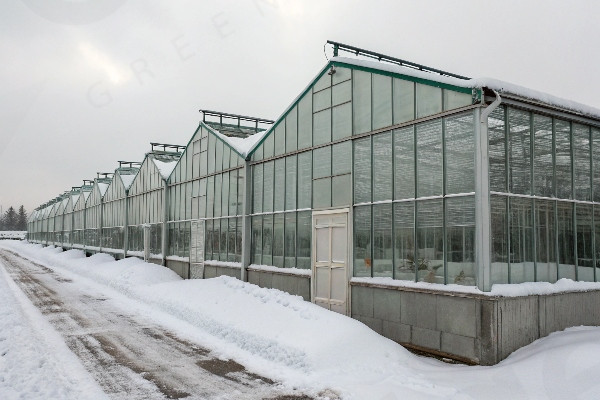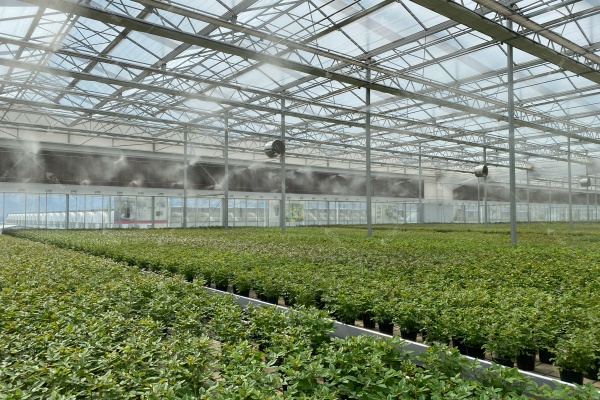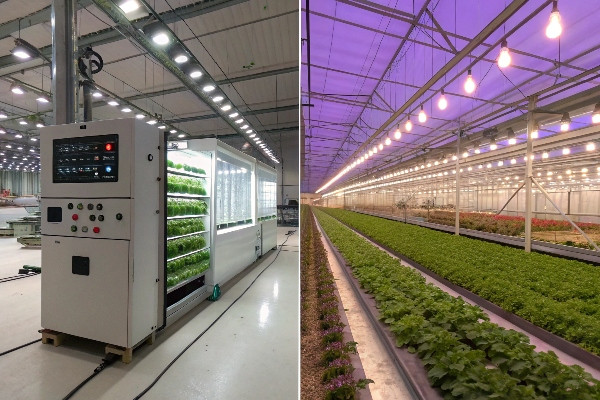Winter strikes fear into every grower’s heart. Your heating bills soar while plants struggle, leaving you wondering if profitable winter growing is even possible.
Winter greenhouse warming combines 16 proven heating methods with proper insulation principles to maintain optimal growing temperatures. Strategic heating and insulation systems can reduce energy costs by 60% while ensuring consistent crop production throughout cold seasons.

After 29 years of installing greenhouse systems across harsh winter climates, I’ve witnessed growers transform their winter operations from financial drains into profitable seasons. The secret lies in understanding fundamental heating principles and selecting the right combination of methods for your specific situation.
Don’t Miss:——Commercial Hydroponic Greenhouse Systems: How Do Design, Construction, and ROI Interconnect?
You might like:——What is a Smart Greenhouse? The Ultimate Guide to Automated Growing
Why Do Greenhouses Get Cold? Key Points for Winter Insulation
Your greenhouse becomes a giant heat sink during winter months. Glass and plastic coverings conduct cold temperatures inside while creating massive surface areas for heat loss through radiation and convection.
Greenhouse structures lose heat through conduction (40%), radiation (35%), and air infiltration (25%). Proper insulation systems targeting these three loss mechanisms can reduce total heat requirements by 50-70%, making any heating method far more efficient and economical.
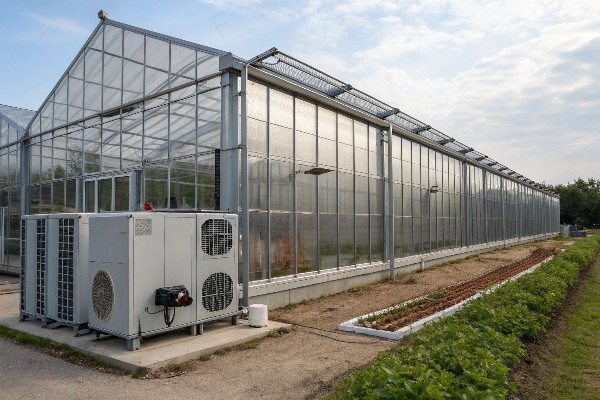
Heat loss happens through three distinct physical processes that work against your heating efforts. Conduction occurs when cold outside air temperatures transfer directly through your covering materials to the inside air. I remember visiting a cucumber grower in Saskatchewan who couldn’t understand why his propane costs were crushing his profits. We measured his single-layer plastic greenhouse and found only a 12-degree temperature difference between inside and outside air on a -15°F night.
Radiation heat loss steals your expensive heated air through infrared energy that passes right through transparent coverings into the cold night sky. This process accelerates dramatically on clear winter nights when there’s no cloud cover to reflect heat back toward earth. Plants and soil surfaces emit this radiant energy continuously, creating a steady drain on your heating system.
Air infiltration brings cold outside air into your greenhouse through gaps, cracks, and ventilation systems while allowing warm heated air to escape. Even tiny openings around doors, vents, or structural connections create significant drafts. During a winter energy audit in Minnesota, we discovered that poorly sealed door frames were responsible for 35% of one facility’s total heat loss.
Commercial Insulation System Design
Our company installs two primary insulation approaches in commercial greenhouse operations. Top insulation systems deploy retractable curtains or screens below the roof structure, creating an insulating air gap that reduces heat loss through the roof by 45-55%. These automated systems close when temperatures drop and open during sunny days to maximize solar gain.
Four-sided insulation involves retractable curtains on walls and sometimes floor areas. This comprehensive approach becomes essential in extreme cold climates where every surface represents a potential heat loss point. I’ve installed complete four-sided systems in greenhouse facilities across Central Asia where winter temperatures regularly drop below -25°F, and operators report energy savings of 65-75% compared to uninsulated structures.
The timing and automation of insulation deployment significantly impacts effectiveness. Smart control systems monitor both inside and outside temperatures, automatically closing insulation when temperature differentials reach predetermined levels. Manual operation often results in poor timing that reduces efficiency and increases labor costs.
We also design custom external insulation solutions for specific climate challenges. Adding exterior slopes or wind barriers around greenhouse perimeters provides additional protection for film-type structures. These external coverings create double-layer insulation effects while protecting the main structure from wind damage that can increase heat loss through air infiltration.
Greenhouse Heating Solutions for Different Budgets
Every grower faces unique financial constraints when planning winter heating systems. Your available budget determines which heating methods work best, but even modest investments can deliver substantial improvements in temperature control and energy efficiency.
Heating system costs range from $500-50,000 depending on greenhouse size and method selection. Budget solutions like space heaters cost $2-4 per square foot annually while high-efficiency systems cost $8-15 per square foot but reduce long-term operating expenses by 40-60%.

Budget-conscious growers can achieve successful winter heating through careful method selection and strategic implementation. I’ve worked with hobby growers who successfully maintain productive greenhouses using combinations of low-cost heating methods that total under $1,000 initial investment.
16 Proven Heating Methods
Method 1: Portable Electric Space Heaters – Quick installation for emergency heating needs. Costs $100-500 per unit with operating costs of $0.15-0.25 per square foot per month. Best for small greenhouses under 200 square feet.
Method 2: Propane Space Heaters – Reliable heating without electricity requirements. Initial cost $200-800 with fuel costs varying by region. Provides consistent heat output but requires ventilation for combustion safety.
Method 3: Natural Gas Unit Heaters – Most economical fuel option in areas with gas service. Installation costs $1,500-4,000 but operating costs 40-60% lower than propane or electric alternatives.
Method 4: Hot Water Boiler Systems – Even heat distribution through pipes or radiators. Installation costs $3,000-12,000 but provides excellent temperature control and efficiency for medium to large greenhouses.
Method 5: Radiant Floor Heating – Premium heating method with highest efficiency ratings. Installation costs $8-15 per square foot but delivers uniform temperatures and reduced energy consumption.
Method 6: Wood Burning Stoves – Renewable fuel option for rural locations. Initial cost $500-2,000 plus chimney installation. Labor-intensive but provides very low operating costs where wood is abundant.
Method 7: Pellet Stoves – Automated wood heating with consistent fuel supply. Costs $1,500-4,000 installed with moderate operating expenses and reduced labor compared to traditional wood burning.
Method 8: Solar Air Heaters – Passive heating using solar energy collection. DIY versions cost $200-800 while commercial units range $1,000-5,000. Provides supplemental heating during sunny winter days.
Method 9: Geothermal Heat Pumps – Ultra-efficient heating using ground temperature stability. High installation costs $10,000-25,000 but extremely low operating costs and environmental impact.
Method 10: Waste Heat Recovery – Capturing heat from compost, equipment, or other sources. Implementation costs vary widely but can provide substantial free heating energy.
Method 11: Thermal Mass Heating – Water barrels, stone, or concrete storing solar energy. Low cost implementation $200-1,000 with significant temperature stabilization benefits.
Method 12: Heat Exchangers – Recovering heat from ventilation air before it exits the greenhouse. Costs $500-3,000 but reduces heat loss during necessary air exchanges.
Method 13: Infrared Heaters – Targeted heating focusing on plants rather than air. Installation costs $300-1,500 per unit with efficient energy usage patterns.
Method 14: Ground-to-Air Heat Exchangers – Underground pipe systems pre-warming incoming air. Installation costs $2,000-8,000 but provides consistent temperature moderation.
Method 15: Biomass Boilers – Large-scale heating using agricultural waste or wood chips. Major installation investment $15,000-50,000 but very low fuel costs for commercial operations.
Method 16: Hybrid Solar-Backup Systems – Combining passive solar collection with automated backup heating. Costs $3,000-15,000 but maximizes renewable energy usage while ensuring temperature security.
Selection Criteria for Different Budgets
Low-budget operations under $2,000 should focus on Methods 1-3 combined with basic insulation improvements. These solutions provide adequate heating for hobby greenhouses and small commercial operations in moderate climates.
Medium-budget projects ($2,000-10,000) can implement Methods 4-8 depending on fuel availability and greenhouse size. These systems offer better temperature control and efficiency that justifies higher initial investment through reduced operating costs.
High-budget installations above $10,000 should consider Methods 9, 15, and 16 for maximum efficiency and lowest long-term costs. These systems work best for large commercial operations where energy savings justify premium equipment costs.
Passive Solar Design: Letting Sunlight Heat Your Greenhouse
Sunlight delivers free heating energy that intelligent greenhouse design can capture, store, and release during cold periods. Passive solar principles help maximize this natural resource while reducing dependence on expensive heating systems.
Properly designed passive solar features can provide 40-70% of winter heating requirements through strategic orientation, thermal mass integration, and glazing selection. Implementation costs $1-5 per square foot but reduces annual heating expenses by $2-6 per square foot.
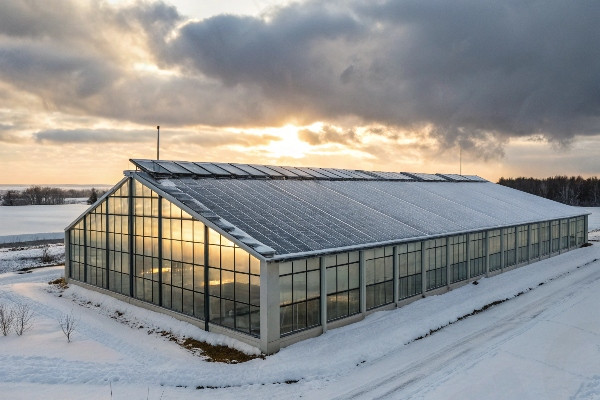
Greenhouse orientation creates the foundation for effective passive solar heating. South-facing structures receive maximum winter sunlight when the sun travels its lowest arc across the sky. I’ve measured temperature differences of 10-15 degrees between properly oriented greenhouses and those facing other directions. Even a 20-degree deviation from true south can reduce solar gain by 25-30%.
The angle and position of your greenhouse affects solar collection throughout the winter season. Structures angled slightly toward the south can capture additional solar energy during low sun periods. I worked with a grower in Montana who increased his solar gain by 35% simply by angling his greenhouse roof 15 degrees toward the south instead of building it perfectly level.
Thermal Mass Integration Strategies
Water storage systems provide excellent thermal mass for solar energy collection and nighttime heat release. 55-gallon drums, large tanks, or even swimming pools can serve as thermal batteries that collect heat during sunny days and release it slowly during cold nights. One innovative grower in Colorado installed a series of black-painted water containers along his north wall that kept his greenhouse 18-22 degrees warmer during clear winter nights.
Concrete and masonry thermal mass offers permanent heat storage that requires no maintenance or replacement. Concrete floors, stone walls, or brick planters absorb solar energy during the day and radiate heat back into the growing space for 6-8 hours after sunset. The thermal mass must be positioned to receive direct sunlight for maximum effectiveness.
Rock and sand thermal mass systems cost less than water or concrete but require larger volumes for equivalent heat storage. Underground rock beds connected to air circulation systems can store daytime heat and release it through controlled air movement during cold periods.
Glazing and Light Management
Double-wall polycarbonate panels provide the best balance between insulation and light transmission for passive solar applications. These panels offer R-values of 2.5-3.5 compared to single glazing R-values of 0.9-1.1, while maintaining 75-85% light transmission rates.
Reflective surfaces multiply solar energy collection without additional equipment costs. White or reflective mulch on floors bounces additional light onto plants while contributing to overall heating. Reflective panels on north walls redirect sunlight back into the growing space instead of allowing it to be absorbed by opaque surfaces.
Automatic thermal curtains maximize both solar collection and heat retention. These systems open at sunrise to capture maximum solar energy and close at sunset to prevent heat loss through radiation and conduction. Proper timing becomes critical – closing too early reduces solar collection while opening too late allows collected heat to escape.
How Can Smart Control Systems Optimize Greenhouse Heating Efficiency?
Modern control systems transform heating management from guesswork into precision science. These systems monitor multiple environmental factors simultaneously and adjust heating output automatically to maintain optimal conditions while minimizing energy consumption.
Smart greenhouse controls reduce heating costs by 30-45% through precise temperature management, predictive algorithms, and integrated system coordination. Control systems cost $2,000-12,000 but typically achieve payback within 12-18 months through energy savings and improved crop consistency.
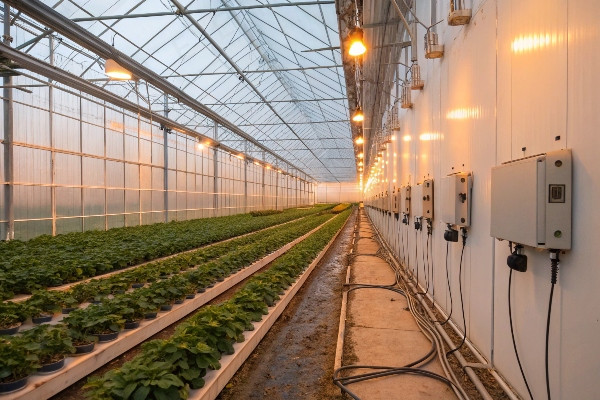
Temperature monitoring throughout your greenhouse reveals microclimates and efficiency opportunities that single-point thermostats completely miss. Multi-zone sensor networks provide real-time data about temperature variations that can stress plants and waste energy. I installed a comprehensive monitoring system for a lettuce grower in Wisconsin who discovered his greenhouse had 14-degree temperature differences between different growing areas. The control system now adjusts heating zones independently, improving both plant health and reducing energy consumption by 28%.
Weather integration capabilities allow control systems to anticipate heating needs based on forecasted conditions and adjust operations proactively. When weather services predict temperature drops, the system can pre-heat greenhouse zones and deploy insulation systems before conditions deteriorate. This anticipatory approach prevents temperature shock to plants while reducing the energy required for rapid temperature recovery.
Humidity coordination prevents the common winter problem of excessive moisture that encourages disease while making plants feel colder than actual air temperatures indicate. Smart systems coordinate heating and ventilation operations to maintain optimal humidity levels without wasting heated air through unnecessary ventilation cycles.
Advanced Control Integration Features
Adaptive learning algorithms analyze your specific greenhouse’s thermal behavior patterns and continuously refine heating strategies based on collected performance data. These systems learn how quickly your structure loses heat, how different heating zones respond to adjustments, and how various weather conditions affect internal temperatures. After several weeks of operation, the system can predict heating needs with remarkable accuracy and automatically optimize energy usage.
Remote monitoring capabilities enable you to track and adjust heating systems from any location using smartphone applications or web-based interfaces. I’ve helped growers troubleshoot heating problems and prevent crop losses from hundreds of miles away using these remote access technologies. Automated alert systems notify you immediately when temperatures fall outside acceptable ranges or when equipment malfunctions occur.
Energy usage tracking and reporting provide detailed analysis of heating costs, efficiency trends, and opportunities for system improvements. These comprehensive reports help identify the most cost-effective times for heating operations and justify investments in insulation upgrades or equipment replacements. Many growers discover that minor adjustments in temperature setpoints or operational timing can reduce heating costs by 15-20% without negatively affecting plant growth or crop quality.
Integration with renewable energy sources maximizes the utilization of solar panels, wind generators, or other alternative energy systems when available. Smart controls can automatically shift heating loads to periods when renewable energy production is highest, further reducing operating costs and environmental impact while maintaining optimal growing conditions.
Conclusion
Successful winter greenhouse heating combines proper insulation principles, appropriate heating method selection, passive solar design, and smart control systems to create efficient, profitable growing environments regardless of climate challenges.

